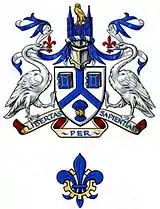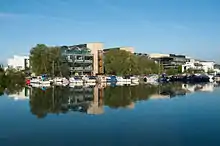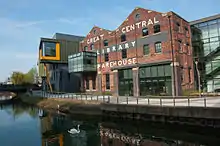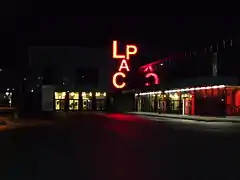University of Lincoln
The University of Lincoln is a public research university in Lincoln, England. The University has origins that trace back to 1861,[7] and obtained university status in 1992 and its present name and structure in 2001.
 | |
| Motto | Latin: Libertas per Sapientiam[1] |
|---|---|
Motto in English | Freedom through wisdom[1] |
| Type | Public |
| Established | 1861 – Hull School of Art 1905 – Endsleigh College 1976 – Hull College 1992 – University of Humberside 1996 – University of Lincolnshire and Humberside 2001 – University of Lincoln |
| Budget | £138.6 million (as of 31 July 2016)[2] |
| Chancellor | Victor Adebowale, Baron Adebowale |
| Vice-Chancellor | Mary Stuart[3] |
Administrative staff | 1,482[4] |
| Students | 15,875 (2018/19)[5] |
| Undergraduates | 13,560 (2018/19)[5] |
| Postgraduates | 2,315 (2018/19)[5] |
| Location | , |
| Campus | Riseholme – 494 acres (200 ha)
Lincoln – 70 acres (28 ha) Holbeach – 11 acres (4.5 ha) |
| Colours | Blue[6] |
| Affiliations | ACU Santander Network Universities UK |
| Website | lincoln.ac.uk |
 | |
Lincoln's main campus is adjacent to Brayford Pool - a site of urban regeneration in the city since the 1990s. Satellite campuses are located in Riseholme, Lincolnshire - home to the Lincoln Institute for Agri-food Technology, and an additional campus at Holbeach which houses the facilities of the National Centre for Food Manufacturing (NCFM).[8] Graduation ceremonies take place every year at the medieval Lincoln Cathedral.[9]
History
Development
The University of Lincoln developed from a number of educational institutions in Hull including the Hull School of Art (1861), the Hull Technical Institute (1893), the Roman Catholic teacher-training Endsleigh College (1905), the Hull Central College of Commerce (1930), and Kingston upon Hull College of Education (1913).[10][11] These institutions merged in 1976 to form Hull College of Higher Education,[12] with a change of name to Humberside College of Higher Education in 1983 when it absorbed several courses in fishing, food and manufacturing based in Grimsby.[10]
1990 onwards
In 1992 it was one of the many institutions in the UK to become full universities as the University of Humberside.[10]
The University of Humberside developed a new campus to the south west of Lincoln city centre, overlooking the Brayford Pool. The university was renamed the University of Lincolnshire and Humberside in January 1996, taking in its first 500 Lincoln students in September 1996.[13]
21st century

With another change of name to the University of Lincoln in October 2001, a new campus was built in Lincoln. The university moved its main campus from Hull to Lincoln in 2002.[14]
Queen Elizabeth II opened the university's main campus in Lincoln, the first new city centre campus to be built in the UK for decades. More than £150 million has been invested in the Brayford Pool campus, transforming a city centre brownfield site, revitalising the area and attracting investment from the retail, leisure and property sectors. Economists estimate that the university has created at least 3,000 new jobs within Lincoln and that it generates more than £250 million every year for the local economy – doubling previous local economic growth rates.[15]
The consolidation involved the University of Lincoln acquiring Leicester-based De Montfort University's schools in Lincolnshire: the Lincoln School of Art and Design in uphill Lincoln, and the Lincolnshire School of Agriculture's sites at Riseholme, Caythorpe and Holbeach. Caythorpe was later closed permanently and its activities moved to Riseholme. Courses held in Grimsby were also moved to Lincoln around this time.
In 2012 all Further Education provision was transferred from Riseholme College to Bishop Burton College. Bishop Burton College are now responsible for the Riseholme College to the north of the city.
Throughout the late-1990s, the university's sites in Hull were considerably scaled down as the focus shifted towards Lincoln. In 2001 this process was taken a step further when the decision was made to move the administrative headquarters and management to Lincoln and to sell the Cottingham Road campus in Hull, the former main campus, to its neighbour, the University of Hull; the site is now the home of the Hull York Medical School. Until 2012 the university maintained a smaller campus, the Derek Crothall Building, in Hull city centre. A smaller campus and student halls on Beverley Road, Hull, were also sold for redevelopment.
On 28 October 2004, following its redevelopment as a specialist food science technology park, the National Centre for Food Manufacturing at Holbeach was reopened by John Hayes, the Member of Parliament for South Holland and the Deepings.
Organisation and administration
Colleges and Departments
The University of Lincoln is structured as a College-based system with each college led by a Pro Vice Chancellor. There are four colleges of study, each comprising schools, institutes and research centres.
- College of Science
- School of Chemistry
- School of Computer Science
- School of Engineering
- School of Life Sciences
- School of Geography
- School of Mathematics & Physics
- Lincoln Medical School
- School of Pharmacy
- National Centre for Food Manufacturing
- Lincoln Institute for Agri-food Technology
- College of Arts
- School of Architecture & Design
- School of English & Journalism
- School of Film & Media
- School of Fine & Performing Arts
- School of History & Heritage
- College of Social Science
- School of Education
- School of Health & Social Care
- Lincoln Law School
- School of Psychology
- School of Social & Political Sciences
- School of Sport & Exercise Science
- Lincoln International Business School (LIBS)
College of Science
The School of Engineering became the first engineering school to be created in the UK for more than 20 years, opening in 2011 in collaboration with Siemens. The building, designed by London Architects Allies and Morrison is the result of a long-standing collaborative effort between the University of Lincoln and Siemens Industrial Turbo-machinery Lincoln. Siemens have co-located their product training facility in custom designed locations within the build.[16]
The School of Mathematics and Physics was opened on 1 September 2014 and officially inaugurated on 1 September 2016 by Professor Efim Zelmanov. Since the beginning of the 2017/18 academic year, the school now shares the new Sir Isaac Newton Building with the School of Computer Science and the School of Engineering.
College of Art
The College of Arts undertakes research and has a range of undergraduate and postgraduate degrees available. The College is also home to Siren Radio, a community radio station based at the University which broadcasts to the city of Lincoln on 107.3 FM and online.
The School of Film & Media has earned a strong reputation in league tables for its BA and MA Media Production degrees.[17] The Lincoln Sound Theatre was opened in 2010 by Visiting Professor Trevor Dann.[18]
Lincoln is home to the largest centre for conservation and restoration study in the UK. Lincoln Conservation, the University's conservation and material analysis consultancy undertakes projects with clients including the Historic Royal Palaces and the Victoria and Albert Museum.[19]
College of Social Science
The College of Social Science includes the School of Health and Social Care which moved into the Sarah Swift Building in July 2017. The School teaches a variety of professionally accredited course in Nursing and Social Work.
The School of Psychology is housed in the purpose-built Sarah Swift Building, also shared with the School of Health and Social Care. There are a range of dedicated facilities for these fields, comprising psychology laboratories and a mock hospital ward for learning and teaching.
Lincoln International Business School
The Lincoln International Business School (LIBS) is based in the David Chiddick Building and offers undergraduate, postgraduate, and doctoral level programmes and is notable for its cross-functional approach to business education and diverse methods of delivery. LIBS also offers distance learning and executive education programmes aimed at the working professional. [20]
Governance
Vice-Chancellor
The founding Vice-Chancellor was Roger King. David Chiddick was Vice-Chancellor when the University was renamed to the University of Lincoln. Chiddick's name is honoured in the name of the David Chiddick Building.
Vice-Chancellor, Mary Stuart, was appointed in 2009. The Vice-Chancellor is supported by five Deputy Vice-Chancellors.[21]
Chancellor
The University's second Chancellor since its title change in 2001, Victor Adebowale, Baron Adebowale, was installed in 2008. Previous chancellors have included Harry Hooper and Dame Elizabeth Esteve-Coll.[22]
Academic profile
Reputation and rankings
| National rankings | |
|---|---|
| Complete (2021)[23] | 42 |
| Guardian (2021)[24] | 52 |
| Times / Sunday Times (2021)[25] | 42 |
| Global rankings | |
| ARWU (2020)[26] | 901-1000 |
| QS (2021)[27] | 801-1000 |
| THE (2021)[28] | 501-600 |
| British Government assessment | |
| Teaching Excellence Framework[29] | Gold |
The University of Lincoln is ranked 43rd in the UK by the Times, 42nd by Complete, and 17th by the Guardian in the 2020 rankings, its highest rankings to date.
In 2017, the University of Lincoln ranked 8 in Agriculture & Forestry, and 2nd in Business & Economics in The Complete University Guide rankings.[30]
More than half of its submitted research rated as internationally excellent or world-leading in the UK's last nationwide assessment of university research standards, the 2014 Research Excellence Framework (REF 2014). It was awarded gold in the Teaching Excellence Framework (TEF 2017).[31]
In 2020, the University of Lincoln was named Modern University of the Year in The Times and Sunday Times Good University 2021, being the highest-ranked multi-faculty modern university in the UK, climbing to 45th (out of 135), its highest ever position in the guide. In the same year including it was named one of the world's greatest young universities in the Times Higher Education Young University Rankings, placing 14th in the UK for overall student satisfaction of the 129 mainstream universities in the National Student Survey 2020, and scoring a five-star rating in the QS Stars ratings system of global universities.[32]
Identity
The University of Lincoln's official logo from 2001 to 2012 was the head of Minerva, the Ancient Roman goddess of wisdom and knowledge. From July 2012 the logo was changed to incorporate the university's coat of arms,[33][34] which features swans, fleur de lys and textbooks.
Campus facilities
Library

Located in the Great Central Warehouse (GCW) building, a renovated former industrial railway goods warehouse, the Library was opened in December 2004 on the Brayford campus. In total, the University library houses over 300,000 books, journals, and other articles of reference.
The GCW was constructed in 1907 by the Great Central Railway. It spent the second half of the twentieth century as a builder's warehouse before falling into disrepair in 1998. It was converted into a library (designed by the university's in-house team of architects) and was formally opened in 2004 by the Chief Executive of the UK's Quality Assurance Agency for Higher Education.
In 2005, the conversion won gold and silver for conservation and regeneration at the Royal Institution of Chartered Surveyors (RICS) Regional Awards in Leicester.[35] It has also gained awards from the Royal Institute of British Architects (RIBA).[36]
Live music
Constructed in 1874 by the Manchester, Sheffield & Lincolnshire Railway, The Engine Shed was the only surviving, four-track, dead-end railway building in Lincolnshire. Refitted as an entertainment venue and opened in September 2006, the Engine Shed is now the region's largest live music venue.[37] The venue consists The Engine Shed, The Platform and Tower Bar, which combined can accommodate up to 2,000 people on any given night. As of 2014, the university transferred the operation of The Engine Shed to the Students' Union.[38]
Lincoln Performing Arts Centre

The Lincoln Performing Arts Centre (LPAC) houses a 450-seat multipurpose auditorium designed for live arts performances, conferences, and film screenings. The theatre's programme of events is designed to complement, rather than compete with, those of its neighbouring venues.
Lincoln Science and Innovation Park
The Lincoln Science and Innovation Park is a large redevelopment south of the main university campus. The area will comprise university facilities, including laboratories, as well as space for industry partners to develop new offices and research facilities.
The Science and Innovation Park is being developed in partnership with the Lincolnshire Co-operative.
Sports Centre
Facilities include a double sports hall, four squash courts, synthetic pitches, a fitness suite, a dance studio, eight badminton and short tennis courts, two basketball courts, two volleyball courts, two netball courts, two five-a-side football pitches and a seven-a-side football pitch. This also where the School of Sport And Exercise Science is located with the majority of their facilities being located in this building.
Student life
According to the university, more than a 100 different nationalities are represented among the student population on the Brayford Pool campus.[39] Based on the available 2018/19 academic year data, the total student population was 13,560 undergraduates and 2,315 postgraduates.[5]
University of Lincoln Students' Union
The University of Lincoln Students' Union, dates back to the formation of the university. In 2007, the Students' Union was reconstituted as a company limited by guarantee, and registered as a charity, introducing a more conventional governance structure for students' unions.
The Students' Union supports and represents the students of the University of Lincoln, sabbatical officers are elected by the student body and supported by the staff. A number of sports teams operate in the national BUCS' leagues competing nationally against other institutions.
The Students' Union were awarded NUS (National Union of Students) Higher Education Students' Union of the Year 2014/15 at the annual awards ceremony.[40]
In 2014, ownership of the on campus pub 'The Shed' was transferred to the Students' Union following the acquisition by the university from Greene King, this was later renamed to The Swan. Later this year, the operation of The Engine Shed was transferred to the Students' Union.[38] In 2015, the Students' Union was awarded Best Bar None Gold and named second in the Best Bar None Safest Venue category.[41]
In 2016, following a student referendum,[42] the Students' Union voted to disaffiliate from the NUS following dissatisfaction with the organisation following the controversial 2016 NUS Conference.[43] The decision was taken to formally exit the NUS in December, but a second referendum was held after a number of approaches from students who opposed the first vote. The re-run resulted in 1,302 students voting to remain part of the NUS, with just 437 backing disaffiliation.[44]
In 2019, the union opted to disaffiliate with the NUS[45] after consulting with students through All Student Member meetings in 2018 and 2019. However, this caused backlash across the student body, resulting in a referendum being held to leave the NUS. The results of this referendum[46] were to disaffiliate from the NUS on 1 January 2020, a total of 2614 (15.7%) students turned out to vote with 996 voting to remain, 1,539 voting to leave, and 79 abstaining.
Student accommodation
In Lincoln, there are many accommodation options for students. The university owns and operates the Student Village including the Lincoln Courts and Cygnet Wharf; a waterfront complex situated on the Brayford Pool Campus. In Lincoln Courts, there are 17 blocks of self-catering apartments, each apartment housing five to eight students and Cygnet Wharf, 3 building with flats of 10–12 residents. The site has a range of facilities with a total of 1,037+ bedrooms available including apartments that have been specifically designed for students with disabilities.
Further to this, there is a range of other University-owned and private off-campus student accommodation in Lincoln.
Notable people
Academics
- Jane Chapman – Professor of Communications[47]
- Carenza Lewis – Professor for the Public Understanding of Research
Alumni
- Gordon Baldwin – Potter
- David Firth – Animator and Visual Artist[48]
- Jonathan Foyle – Architectural Historian
- Andrea Jenkyns – MP for Morley and Outwood
- Tom Marshall – Artist and Photo Coloriser
- Paul Noble – Visual Artist
- Vicki Phillips – Educator and Director at the Bill & Melinda Gates Foundation[49]
- Chris Rankin – Film Actor
- Thomas Ridgewell – YouTube Video Creator
- Jayne Sharp – Broadcaster
- Martin Vickers – MP for Cleethorpes[50]
- Juan Watterson – MHK for Rushen[51] and Speaker of the House of Keys
- Dan Wood – Broadcaster
See also
Lincoln is one of two universities in the city, alongside Bishop Grosseteste University.
References
- "University Motto".
- "Financial Statements for the Year to 31 July 2016" (PDF). University of Lincoln. p. 1. Retrieved 3 May 2017.
- "Vice Chancellors Welcome". University of Lincoln. Retrieved 15 July 2011.
- "Key Facts – University of Lincoln". Lincoln.ac.uk. Retrieved 8 June 2017.
- "Where do HE students study?". Higher Education Statistics Agency. Retrieved 1 March 2020.
- Lincoln, University of. "Colours". www.lincoln.ac.uk.
- "Lincoln, University of". The Independent. A-Z Unis & Colleges. London. 27 July 2007. Retrieved 28 August 2008.
- Lincoln, University of. "How to Find Us". lincoln.ac.uk. Retrieved 1 February 2016.
- Lincoln, University of. "Graduation Ceremonies". www.lincoln.ac.uk. Retrieved 11 January 2018.
- "University of Humberside Quality Audit Report". Higher Education Quality Council. January 1996. ISBN 1-85824-219-3. Retrieved 25 February 2011. Cite journal requires
|journal=(help) - David Foster (1997). "Unity out of diversity: the origins and development of the University of Humberside". Continuum International Publishing Group: vii. ISBN 978-0-485-11513-0. Retrieved 28 May 2009. Cite journal requires
|journal=(help) - "Papers of Cyril Bibby (1914–1987)". The National Archives. Retrieved 28 May 2009. Cite journal requires
|journal=(help) - "University of Lincolnshire and Humberside Quality Audit Report, Collaborative Provision". Higher Education Quality Council. January 1997. ISBN 1-85824-290-8. Archived from the original on 6 June 2010. Retrieved 25 February 2011. Cite journal requires
|journal=(help) - "University of Lincoln Institutional Audit". The Quality Assurance Agency for Higher Education. March 2008. ISBN 978-1-84482-850-0. RG380 07/08. Archived from the original on 22 April 2009. Retrieved 25 February 2011. Cite journal requires
|journal=(help) - "Lambert Review of Business Collaboration" (PDF). HM Treasury. Archived from the original (PDF) on 29 January 2013. Retrieved 1 February 2016. Cite journal requires
|journal=(help)" - "First brick cements new School of Engineering's city presence". University of Lincoln. Retrieved 2 February 2011.
- "University of Lincoln". Retrieved 15 July 2015.
- "Radio supremo Trevor Dann to speak at Lincoln this Wednesday". Lincoln.ac.uk. Retrieved 8 June 2017.
- "Conservation".
- "Lincoln International Business School | University of Lincoln". www.lincoln.ac.uk. Retrieved 26 June 2020.
- Lincoln, University of. "Senior Management Team". www.lincoln.ac.uk. Retrieved 6 June 2019.
- "History of the University". University of Lincoln. Retrieved 22 June 2011.
- "University League Table 2021". The Complete University Guide. 1 June 2020.
- "University league tables 2021". The Guardian. 5 September 2020.
- "The Times and Sunday Times University Good University Guide 2021". Times Newspapers.
- "Academic Ranking of World Universities 2020". Shanghai Ranking Consultancy.
- "QS World University Rankings 2021". Quacquarelli Symonds Ltd.
- "World University Rankings 2021". Times Higher Education.
- "Teaching Excellence Framework outcomes". Higher Education Funding Council for England.
- "University guide 2017: league table for Agriculture & Forestry". The Complete University Guide. Retrieved 25 April 2016.
- "University of Lincoln reputation". University of Lincoln.
- Lincoln, University of. "University of Lincoln Press Office". University of Lincoln. Retrieved 23 September 2020.
- Lincoln, University of. "Coat of Arms". www.lincoln.ac.uk.
- "University of Lincoln swaps Minerva logo for swans". The Lincolnite. Lincoln. 18 July 2012. Retrieved 20 July 2012.
- "Gold and Silver for Library Conversion". University of Lincoln. 27 June 2005. Retrieved 8 September 2008.
- "Converted library garners another award".
- "University of Lincoln-Higher Education Profile". The Guardian. London. 1 March 2008. Retrieved 28 August 2008.
- "Lincoln students can look forward to Tower Bar and the Engine Shed's new SU management". The Linc. Retrieved 12 February 2016.
- Lincoln, University of. "Key Facts". www.lincoln.ac.uk. Retrieved 13 February 2016.
- "NUS Awards 2016". www.nusawards.org.uk. Retrieved 13 February 2016.
- "University of Lincoln Students' Union". lincolnsu.com. Retrieved 13 February 2016.
- https://lincolnsu.com/news/article/nus-referendum
- "University of Lincoln Students' Union NUS Referendum". lincolnsu.com. Retrieved 9 May 2016.
- https://www.thejc.com/lincoln-students-overturn-vote-to-split-from-nus-1.53911
- https://lincolnsu.com/news/article/nusupdate
- https://lincolnsu.com/news/article/referendumresult
- Online Services Team. "Jane Chapman · University of Lincoln Staff Directory". Staff.lincoln.ac.uk. Retrieved 7 June 2017.
- "David Firth cartoons on show at film festival" Archived 24 September 2015 at the Wayback Machine, [Hull Daily Mail]. Retrieved 11 April 2014
- "University of Lincoln", [The Complete University Guide]. Retrieved 25 April 2016
- "Martin Vickers", The Telegraph. Retrieved 26 December 2011 Archived 31 August 2011 at the Wayback Machine
- "Archived copy" (PDF). Archived from the original (PDF) on 23 February 2012. Retrieved 16 December 2015.CS1 maint: archived copy as title (link)
External links
| Wikimedia Commons has media related to University of Lincoln. |